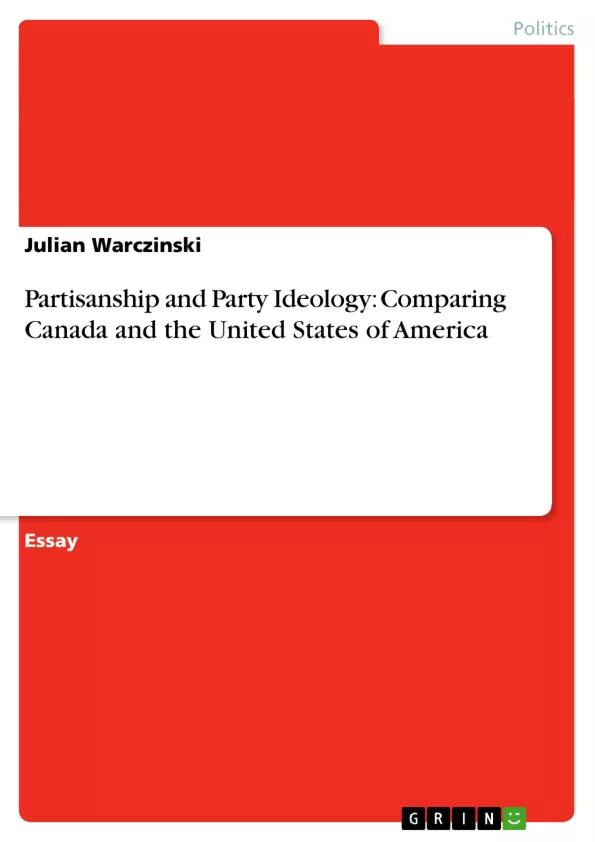Canada and the United States of America have equally developed a form of structural federalism, both use a single-member plurality election system and have similar social and economic class structures. In contrast to the two-party tradition of the US in a presidential system, Canada has developed a multiparty parliamentary system in which the legislative parties are cohesive and disciplined due to the historical influence of British Westminster System. In general party identification has been defined as “an attachment to a party that helps the citizen locate him/herself and others on the political landscape.” The aim of this paper is to explore the possibility of shifts in ideological party identification with respect to the significantly different party systems in Canada and the United States, with special focus on the time span between 1984 and 2000. The central question discussed in this paper is whether or not there has been a significant change in partisan ideology in Canada compared to the United States between 1984 and 2000, and whether Canadian Partisans are more volatile compared to their southern counterparts in terms of ideological party identification.
Inhaltsverzeichnis (Table of Contents)
- Introduction
- Defining Party Identification
- Factors in Party Identification
- Democrats and Republicans
- Ideological Self Placement of American Partisans
- Ideological Self-Placement of Canadian Partisans 1984
- The 1993 Elections in Canada
- Ideological Self-Placement of Canadian Partisans 2000
- Conclusion
Zielsetzung und Themenschwerpunkte (Objectives and Key Themes)
This paper aims to explore potential shifts in ideological party identification in Canada and the United States, considering their distinct party systems. The central question is whether there has been a significant change in partisan ideology in Canada compared to the United States between 1984 and 2000, and whether Canadian partisans are more volatile in terms of ideological party identification than their American counterparts.
- The evolution of party identification in Canada and the United States
- The impact of the 1993 elections on Canadian partisan ideology
- The factors influencing party identification in both countries
- A comparative analysis of ideological self-placement among Canadian and American partisans
- The role of political parties in a democracy
Zusammenfassung der Kapitel (Chapter Summaries)
- Introduction: Introduces the topic of partisan ideology in Canada and the United States, highlighting their similarities and differences in terms of political systems and party identification. The paper aims to investigate the possibility of shifts in ideological party identification during the period between 1984 and 2000.
- Defining Party Identification: Defines party identification as an attachment to a party that helps individuals locate themselves and others on the political landscape. It highlights the importance of partisanship in understanding voter behavior and the role of political parties in a democracy.
- Factors in Party Identification: Examines the various factors that contribute to an individual's party identification, including social, economic, and regional influences. It explores the evolution of party identification in both Canada and the United States, referencing historical studies and contrasting findings.
- Democrats and Republicans: (This section likely focuses on the ideological positions of the major parties in the United States.)
- Ideological Self Placement of American Partisans: (This section likely explores the self-perceived ideological positions of American partisans.)
- Ideological Self-Placement of Canadian Partisans 1984: (This section likely analyzes the self-perceived ideological positions of Canadian partisans in 1984.)
- The 1993 Elections in Canada: (This section likely examines the impact of the 1993 elections on Canadian party system and partisan ideology.)
- Ideological Self-Placement of Canadian Partisans 2000: (This section likely analyzes the self-perceived ideological positions of Canadian partisans in 2000.)
Schlüsselwörter (Keywords)
This paper focuses on the concepts of partisanship, party identification, ideological self-placement, political systems, voter behavior, and the comparative analysis of Canada and the United States.
- Quote paper
- Julian Warczinski (Author), 2007, Partisanship and Party Ideology: Comparing Canada and the United States of America, Munich, GRIN Verlag, https://www.grin.com/document/93256



